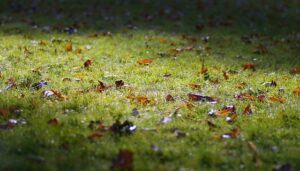Seeding, or indeed reseeding, can be a tricky thing to perfect. As a lawn owner you want to get it right the first time, as you may only have one good shot at it. So with this sort of pressure in mind, when is the best time to sow lawn seed?
Autumn is regarded by many as the perfect time of year to establish a new grass. Let’s have a look at the facts of the matter, to work out once and for all whether this statement is true.
The Type of Grass Planted
Grasses can generally be bundled into two different categories – warm season and cool season. In the most basic of terms, warm season grasses prefer warmer conditions, and cool season grasses prefer (you guessed it) cooler conditions. Australia, being the warm part of the world that it is, has conditions that are generally more suitable for warm season grasses.
The likes of Couch, Kikuyu and Buffalo are all warm season grasses, and have become popular thanks to their ability to take the Australian heat. Save for Tasmania and some parts of southern Victoria, you’ll overwhelmingly see warm season grasses being planted in Australian front and backyards.
This is important when it comes to seeding timing, as warm and cool season grasses require slightly different conditions to establish as they should. So what conditions do warm season seeds require?
The Perfect Temperature
In order to establish a warm season seed you want a soil that sits at 18C or above for an extended period – ideally a couple of weeks – while the seed sprouts and takes hold. If you drop below that temperature the seed will go semi-dormant and won’t establish properly.
In temperate parts of Australia, below the sub-tropics, soils in winter will be well below this mark. The cool mornings of spring will also affect a seed’s ability to establish, so that season is out too. Summer will obviously bring the warmest temperatures of the year, and as such will allow your seeds to comfortably establish. And finally, autumn enjoys the residual warmth of the summer, particularly in the soil, so will also meet the temperature needs of a warm season grass seed.
So we’re left with summer and autumn as warm season seed growing options. But what else do we need to think about?
The Right Amount of Moisture
An establishing lawn is a drinking machine. It needs to be kept constantly moist in order for it to take hold and establish as quickly as possible. Newly sown seed usually requires multiple soaks a day in order for the soil it sits in to stay at the ideal moisture level.
In summer this moisture level is far more difficult to maintain. With long hot days and extreme UV sapping the moisture from the soil, a lawn owner will find themselves on the hose far more often than if the lawn is planted in autumn, when milder temperatures allow for a more relaxed approach.
The Less Extreme the Better
Indeed, the extremes of summer can serve to stress a newly planted grass out, whether the right amount of water is being applied or not. If your newly establishing blades are subjected to multiple days of 40C+, you’ll find that the stress and strain of the conditions will force your new blades to put a focus on surviving rather than growing in the heat. Again, autumn provides a less stressful start to a new lawn’s life.
A Peak Growing Period
Added to all that, autumn is actually most warm season grasses’ peak growing period – the time of year in which they’re most active. That means that a newly sown turf will establish quicker at this time of year than any other.
All in all, autumn represents the perfect time to sow your new warm season grass. But if you’ve got any further questions on when, where and how to sow, don’t hesitate to contact the friendly team at McKays!
Does perennial ryegrass come back every year?
Perennial ryegrass is a type of grass that does indeed come back every year. This is in contrast to annual ryegrass, which only lives for one growing season before dying off. Perennial ryegrass is a popular choice for lawns and turfgrass because it is very hardy and can withstand a lot of wear and tear. It is also relatively low-maintenance, requiring only occasional mowing and watering.
How do you care for perennial ryegrass?
Perennial ryegrass is a versatile and hardy grass that is easy to care for. It tolerates a wide range of soils and climates, and is relatively drought-resistant. However, like all grasses, it does require some basic maintenance in order to stay healthy and looking its best.
Mowing is the most important aspect of care for perennial ryegrass. It should be mowed regularly, at least once a week, to keep it from getting too tall. The height of the grass should be kept at around 3 inches. This will ensure that the grass stays dense and lush, and prevents it from developing bare patches.
Perennial ryegrass also needs to be fertilized periodically. A slow-release fertilizer should be applied every 6-8 weeks during the growing season. This will help the grass to maintain its green color and keep it from getting thin and weak.
Finally, perennial ryegrass needs to be watered regularly. It should be watered deeply and evenly, about 1 inch per week. This will help it to develop a deep root system and stay healthy during periods of drought.
How long does perennial ryegrass take to establish?
Perennial ryegrass is a type of grass that is often used for lawns, pastures, and other areas where a grassy surface is desired. It is a fast-growing grass that can establish itself quickly, often in as little as two weeks. Once established, it is a hardy grass that can tolerate a wide range of conditions, from drought to heavy traffic.
What time of year do you plant perennial ryegrass?
Perennial ryegrass is a cool-season grass, which means that it thrives in cooler temperatures and goes dormant in hot weather. In general, you should plant perennial ryegrass between Autumn and Spring, when the temperatures are cool. This gives the grass the best chance to establish itself.
Test
test



